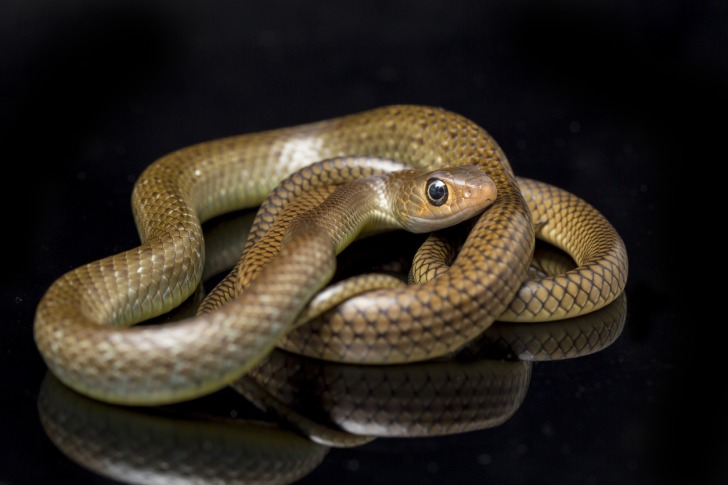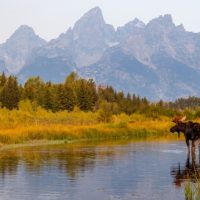When many people think of California, they may envision beautiful beaches, mountainous coastlines, cactus-filled deserts, and picturesque woodlands.
Rightfully so, California boasts a variety of different geographical terrains and ecosystems throughout the state.
Within the Golden State’s varied environments, there are over 40 different snake species to be found.
While most of the snakes in California are not dangerous, there are a few to be aware of when enjoying outdoor activities.
Let’s take a closer look at which California snakes are harmless and which ones you should avoid.

Contents
So… Are There Snakes in California?
The short answer is yes, there are many snakes in the state.
California’s pleasant climate and variety of environmental options offer excellent habitat choices for many species of snakes.
The good news is that many of the species present are of no danger to humans.
Many are beneficial in reducing rodent and pest populations.
Some snakes, like the King snake, actually hunt and eat other more dangerous and venomous snakes, such as Rattlesnakes.
Snake Species in California
As mentioned earlier, California has around 40 native species of snake throughout the state.
There are also a few non-native species that have established a consistent population within the state.
Boas
First up on our list are the Boas.
Although many may recognize and associate these snakes with Boa Constrictors, the California Boas pose no threat to humans, either from venom or lethal constriction.
The rubber and Rosy variety Boas in California are quite docile and will often attempt to hide or escape when threatened.
The Southern and Northern Rubber Boas will often contort themselves into a ball and hide their heads when they sense danger.
Both species of Rubber Boa can be found in the middle to upper portion of the state and are often found in mountainous or forest ecosystems.
By contrast, the Rosy Boa is often found in the more desert-like conditions of Southern California.
Glossy Snakes
Another non-venomous species, Glossy snakes are often found in desert conditions and microhabitats.
They are nocturnal hunters and capture prey through ambush.
Glossy snakes are not very big, so they can conceal themselves in rocky crevasses, under low bushes, or even in loose soil.
Beyond California, Glossy snake species can be found throughout the Southwest states and into Mexico.
Shovel-nosed Snakes
The Shovel-nosed are small, non-venomous snakes that are usually found in Southern California’s desert regions.
Both the Mojave and Colorado Desert species have alternating ringed color patterns.
The Colorado Desert shovelnose coloring is designed to mimic the more dangerous Coral snake.
Shovelnose snakes are nocturnal and often burrow for protection during the daytime.
Their diet mainly consists of insects and invertebrates.
North American Racers, Coachwhips, and Whipsnakes
These slender and fast-moving snakes can grow to lengths over 5 feet, but are non-venomous and aren’t usually a threat to humans.
Racers and Coachwhips may strike at a human as a means of defense.
When threatened, though, this species of snake will often make a hasty exit.
These snakes are named after their physical appearance as well as their movements and evasion techniques.
They can be found in a variety of settings, from deserts to coastal and mountainside regions.
Their diet primarily consists of small mammals, lizards, and insects, with birds and even other snakes also making the menu, on occasion or when available.
Ring-Necked Snake
These small, thin snakes often have brightly colored underbellies, which they can expose as a defense mechanism.
Although not typically considered dangerous to humans, they can produce a mild venom, which is believed to be used primarily as a hunting mechanism.
California is home to at least 7 specific varieties of Ring-necked snakes, and they can be found throughout the state.
Kingsnakes and Milksnakes
Sometimes referred to as the king of snakes, the Kingsnake is unique in that it is immune to Rattlesnake venom.
This means that the Kingsnake can regularly make a meal of one of the more feared and venomous snakes.
In addition, they feed on mammals, birds, insects, reptiles, and other snake varieties.
They are a strong constrictor and capable of taking prey larger than themselves.
Fortunately, Kingsnakes are not venomous and pose very little threat to humans.
The California Mountain Kingsnake is another impostor snake, with a ringed pattern and coloration which mimics the Coral snake.
Luckily, there are no Coral snakes found in California, so no unfortunate identification mistakes should occur.
Gopher Snake
One of the more prevalent and wide-ranging snakes in California, the Gopher snake species are non-venomous and pose no threat to humans.
Gopher snakes are powerful constrictors and make their diet off of small mammals, especially those that burrow.
For Gopher Snakes, their real power is in their ability to scare away or evade potential threats.
To start, a Gopher snake can appear similar to a Rattlesnake in markings and coloration, although with a noticeably more slender head.
Gopher snakes will also vibrate their tail like a Rattlesnake, but can also hiss loudly, flatten and widen their bodies, become rigid like a stick, and, if all else fails, crawl away quickly.
Garter Snakes
One of the most prevalent species of snakes in California, Garter snakes have a mild venom and their bite should be avoided.
Overall, they pose no threat to humans, though, as their venom is primarily used for capturing prey.
Garter snakes can be found throughout the state and can thrive in many different environments.
Garter snake varieties have slightly different appearances and can be identified accordingly.
Rattlesnakes and Sidewinders
Grouped in the viper category are some of the most dangerous and deadly snakes in California, as well as the rest of the United States.
Rattlesnakes of any kind should be considered very dangerous.
Any outdoor activity in California should include the possibility of an encounter with a species of rattlesnake.
Often identified from their rapid tail movement, which shakes their “rattles”, these snakes can strike and inject venom into a person from up to three feet.
Vipers can also be identified by their large, triangular-shaped heads.
Rattlesnakes are of such danger that even an incapacitated snake can still bite and inject venom.
Be on high alert when encountering any rattlesnakes.
Proper boots and hiking attire are suggested for areas known as snake habitats.
Treatment for bites should be rapid and with trained medical personnel.
Yellow-bellied Sea Snake
Since California has a large coastline, there is also the possibility of an encounter with a sea snake.
Sea snake venom can be some of the most toxic.
Fortunately, these snakes have smaller teeth and most bites occur when a snake is caught in a fishing net.
They are mainly found in the southern waters of California.
They can be identified by their bright yellow underbelly.
If seen in the wild, it is imperative to avoid contact and the potential of a bite.

Is it Safe to Go on a Trek in California?
California, as a state, offers some of the best and most beautiful outdoor scenery in the country.
From sea to mountaintop, California has a little bit of everything for those who enjoy the outdoors and nature.
That being said, it is important to be diligent about your surroundings at all times.
In addition to rattlesnakes, California has bears, mountain lions, cougars, wolves, and coyotes.
Spiders and insects like Black Widow spiders and scorpions are also found in California.
And if you decide to hit the beach, just be aware that many species of sharks, like the Great White and Mako, are often cruising the kelp beds.
California is beautiful and has lots to offer.
Just be careful while you enjoy it.
Interesting Snake Facts in California
The San Francisco Garter Snake is considered to be the “most beautiful serpent in North America.”
The Kingsnake’s young are often varied in their markings and coloration from their parents and siblings.
3 Safety Tips for Exploring Nature in California.
Stay safe when exploring California’s natural wonders.
If possible, hike and explore with a partner.
Always tell someone where you’re exploring and how long you’ll be gone, especially if you’re going alone.
Pack a bag with water, snacks, first aid equipment, a portable phone charger, and a thermal blanket or jacket.
Getting lost is never any fun. Having some temporary supplies always helps.
Avoid animal encounters if at all possible.
Nature is wonderful for exploring and observing, but should be respected.
Summary
California’s beauty is well-known and, if you’ve never visited, it should be a goal to see it one day.
From the massive redwoods of Big Sur to the snowy peaks of Mt. Shasta, California never fails to impress.
When you are exploring California, be careful with rattlesnakes.
As snakes go, they pose the greatest threat to humans and should be avoided whenever possible.
Overall, just remember to stay alert and be aware of your surroundings at all times.
California Safety Overview
READ THE FULL REPORT: California Safety Review
Safety Index:
- OVERALL RISK: MEDIUM
- TRANSPORT & TAXIS RISK: MEDIUM
- PICKPOCKETS RISK: MEDIUM
- NATURAL DISASTERS RISK: HIGH
- MUGGING RISK: MEDIUM
- TERRORISM RISK: MEDIUM
- SCAMS RISK: HIGH
- WOMEN TRAVELERS RISK: MEDIUM
Frequently Asked Questions
How many people die every year in California from snake bites?
Roughly 200 people are bitten by snakes in California annually.
Of those bitten, less than one-half of one percent end up fatal.
Are snakes a problem in Los Angeles?
Snakes aren’t usually found in great numbers in LA.
Most snakes in California will be seen in the wild on hiking trails or desert escarpments.
What is the best method for treating a venomous snake bite?
Ideally, a snakebite patient should go to a hospital as soon as possible or call 911.
In most cases, antivenom can be administered to combat the effects of snakebite.
If a hospital is not nearby, the patient is advised to stay calm and not move, to avoid spreading the venom through the bloodstream.
The bite wound can be washed with soap and water and dressed lightly.











